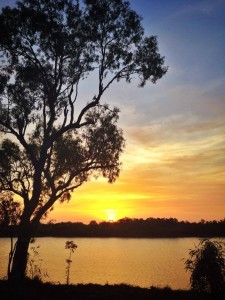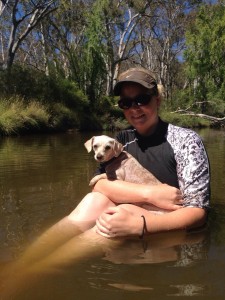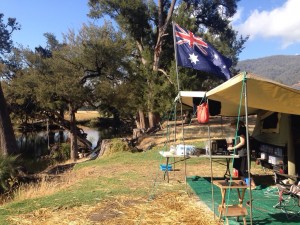Touring Australia on a Budget
It’s on the bucket list of millions of people around the globe. The great Australian road trip. Australia is such a vast country that you could travel around it for years on end and still not see it all. And the travel bug doesn’t discriminate on age. In our travels we have met retired “Grey Nomads” named for their grey hair, young backpackers from all over the world, as well as young families that have hit the road for a year before the kids start school. There is no set demographic, and that’s because Australia’s beauty appeals to everyone.
The changes in terrain are staggering. In one day you could start your drive through roads of thick bush, by lunch time you are winding your way through mountain rain forests, then spend the afternoon cruising the open grass and desert plains. On the very same day, the East of the country might be in flood, 300km to the West in drought. To the North is experiencing a record breaking heatwave, while it is snowing in the South.
The seasons play an important role in Australia’s beauty too. If you were to visit remote Northern Territory over Winter, you will be met by dry and arid open plains. Brown grasses and trees that look like they are on the brink of death, blistering in the searing sun. Dried up creek beds, wrinkled with rock hard plates of hardened mud. Once Winter ends and the Summer wet season arrives, the North comes alive again. Lush green, tall grasses blanket the plains. Creeks and waterholes not only fill with water, but entire ecosystems. Fish, frogs, birdlife and all kinds of wildlife thrive where just weeks ago they didn’t seem to even exist.
These are some of the reasons that makes Australia so unique. This is why people love to travel here. Beyond all other restrictions, by far the biggest thing holding people back from traveling Australia is budget. If you let it, touring around can be very expensive. But it doesn’t have to be. And don’t think that by spending more money you will have more fun. It’s simply not true.
All you need is careful planning and make some educated decisions about your trip. Before planning your trip, you need to consider that there are hundreds of different ways you can tour around Australia. Some people simply pack the family sedan and head off, planning to stay in motels. Others have big caravans to take all the luxuries of home with them. Others are happy to sleep under the stars in a swag or tent. All of these are perfectly reasonable options, but which one is right for you and which one fits your budget best?
Before you even think about planning your trip, you need to know what you are in for and what expenses to expect.
I’ve come up with a list of five items that will dominate your budget, both in the setup stage before you leave home, to the ongoing and daily costs while traveling. The five budget items are:
1.) Accommodation
 So where do you plan on sleeping? My current setup is a cheap, second-hand camper trailer. We bought it for $4,000 and it has now followed us for tens of thousands of kilometres around Australia on many different trips. We have found this a very cheap way to travel, while still having storage space to carry loads of camping gear under the bed in the trailer.
So where do you plan on sleeping? My current setup is a cheap, second-hand camper trailer. We bought it for $4,000 and it has now followed us for tens of thousands of kilometres around Australia on many different trips. We have found this a very cheap way to travel, while still having storage space to carry loads of camping gear under the bed in the trailer.
If budget was your number one priority, then you can simply buy a swag each for the whole family, or a couple of tents. You can pick up tents so cheap these days that they are almost a throw away item that you can trash at the end of your trip. And if you decide to travel this way, you are still going to have fun. It’s just a little rougher and less comfortable, but by far the cheapest start-up cost.
On the other end of the scale, by spending more on your startup by purchasing a small caravan you might find yourself saving money in other areas of your trip. For example cooking food is so much more convenient that you will probably rarely eat expensive takeaway food.
When deciding on your accommodation, weather it’s a tent, caravan, camper or motor home I would simply recommend you choose the best reasonable option you can afford. And start out smaller. There is always a chance you will get two weeks into your trip around Australia and decide it’s not for you. That’s unlikely though.
2.) Choosing your vehicle

Your accommodation and vehicle choice go hand in hand. If you are towing a camper or caravan, you need to take into account the towing capacity of your vehicle. You can take years off the life of your engine by pushing it too hard. Also if you are loaded over the towing capacity, you might void your insurance if you need to make a claim.
When choosing a vehicle, I’m sure a four-wheel-drive is the first thing that comes to mind for most people. But a fourby is not by any means essential. On your travels you will certainly drive on many dirt roads, but actual four-wheel-driving you will probably do a lot less of than you expect.
In years gone by, everyone would recommend that you only travel in a diesel vehicle. This was because some places only sold diesel fuel. However in our travels, we have always been able to purchase unleaded fuel regardless of how remote we are.
Our car is a Suzuki Grand Vitara. It’s a small four-wheel-drive. We very rarely have it in low range. I’d say only a handful of times. We only tow a small camper trailer, so it’s perfect for us. If we could change one thing about the car it would be the fuel tank. It only has a 60 litre tank, and that’s only JUST enough fuel to get us from Barkly Homestead to Cape Crawford in the Northern Territory. It’s a road we travel regularly and is about 400km between petrol stations.
Oh, and cruise control! I’d put cruise control on my wish list too.
3.) Free Camps
Some people love caravan parks and only ever stay in them. This is the best way to blow your money if you are traveling on a budget. You could easily spend $300 a week staying at caravan parks.
We tend to seek out free camps. Free camps are great because you can spread out a bit more, there are less rules and they are of course FREE! Free camps come in all shapes, sizes and setups. The best free camps have flushing toilets and showers. Some are less fancy, but you really can’t complain about the price.
Carcoar Dam Free Camp in NSW for example is superb. The facilities are great, the lawns mowed and a beautiful outlook over the dam and rolling green hills.
Uralla Fossicking Area Free Camp near Armidale on the other hand has stinky drop toilets with doors that don’t lock and there is very little flat ground to setup camp. But as mentioned before, you simply cannot complain about the price! We actually very much enjoyed our time camping at Uralla, swimming daily in the lovely creek with our dogs.
These are just a couple of examples of free camps. There are thousands of them! Some have no toilets. Some are just a rest stop on the side of the road. We free camp as much as possible. It’s more fun and better for the budget.
4.) Fuel
This one is simple. If you are not prepared to spend $2.20 a litre on fuel at some point on your trip, then traveling Australia is not for you. The more remote you go, the more expensive fuel will be there. And rightly so.
It’s not just the extra cost in getting fuel there, their whole operation is more expensive. Cape Crawford for example is in the middle of nowhere and completely off the grid. They have to generate their own power and pump their own water. It’s not connected to any town, so staff are living on site. If something breaks, the nearest technician could be in Darwin 800km away. So is their $2.20 a litre justified? Yes.
To combat the price of fuel, the best thing you can do is preserve it. It is the easiest thing to do. You just need to slow down. What’s the rush anyway?
On a section of one of our trips a few years ago, we were following friends in another car in front of us. We were towing our camper, and they were towing nothing. Being in the Northern Territory we were allowed to travel at 130km/h. Driving at 130, you could almost see the needle on the fuel gauge going down. On this section of road we usually travel at about 90km/h, mostly because the road is terrible, but secondly because we use way less fuel. We usually reach our destination with a quarter of a tank to spare. But on this occasion travelling at 130km/h our low fuel light came on when we were still 150km from the next fuel station. A massive, massive difference in fuel consumption.
Lucky I travel with 2 jerry cans on fuel, so I was able to stop and put more fuel in.
In summary, SLOW DOWN and save a heap of money on fuel.
5.) Food
Cooking dinner should be one of the most enjoyable parts of your trip. Cooking on a fire, BBQ or camp oven is so much fun. It’s almost a challenge to see how fancy you can make a meal while camping.
The rest of the days food can be a challenge. Especially when driving long distances. If we hit the road early in the morning, we usually end up at a roadhouse spending money on bacon and egg sandwiches and coffee. There’s $20. Mid morning fuel top up, a hot box catches your eye. “3 wing dings and two dim sims please.” Add that to the two cans of coke and a bag of chips and you’ve just spent another $20. That’s $40 on food before lunch. Almost $300 a week!
I suppose what I’m getting at is everything adds up. Very quickly. The cheapest and most enjoyable solution to this is to again SLOW DOWN and take the time to prepare your own meals. There are rest stops everywhere to do this. Stop and make sandwiches.
We like to support small businesses in country towns, so we will usually find a bakery and buy some bread then find a butcher and pick up something for dinner. A lot cheaper than fast-food crap.
Ok, so that’s my five budget items to consider BEFORE planning your trip. After considering all five points, so you can start to ask yourself questions like:
– How long do I want to/able to travel around Australia?
– Where do I want to visit? How much of the country can I see?
– What time of year do I want to travel?
I hope you’ve enjoyed reading this and feel free to ask any questions in the comments below. Safe travels.










